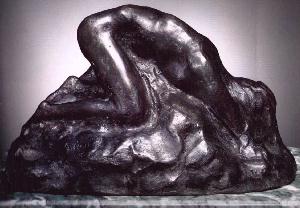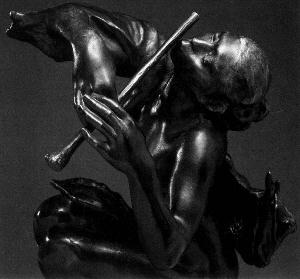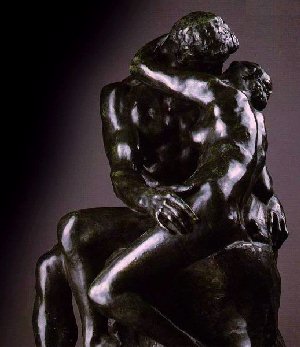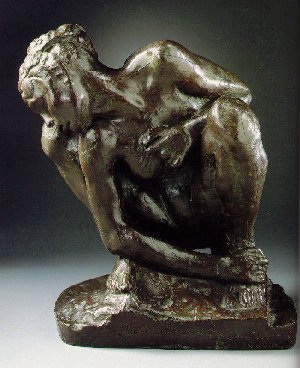| Auguste Rodin Modern Art History Auguste Rodin (1840 - 1917) Childhood 1840-1858 Born to modest means on November 12, 1840, François-Auguste-René Rodin was the second child of Jean-Baptiste Rodin and Marie Cheffer. He was somewhat shy and very nearsighted, which proved a hindrance in his early academic work. He took a serious interest in drawing and had his first drawing lesson when he was ten years old. His father tried to help him academically by sending him to his uncle's boarding school in Beauvais in 1851. He remained there for three years, but still had difficulty reading and writing, and the time was soon approaching for him to learn a trade. Devoting himself to drawing early on, Rodin enrolled at the École Impériale de Dessin, a government school for craft and design (also called the "Petite École" or "Small School" to distinguish itself from the more prestigious École des Beaux-Arts, or "School of Fine Arts".) He kept himself very busy, attending classes at La Petite École, visiting museums to study antique sculpture, and attending the Gobelins tapestry manufactory, where he also studied drawing. During these early years he also discovered clay and found himself to be a very capable and promising sculptor. Although he was awarded two prizes for drawing and modeling at the age of seventeen, Rodin was unable to gain admittance to the prestigious and conservative École des Beaux-Arts, which rejected him three times. Early Struggles 1858-1870 To help support his family Rodin began working commercially in the decorative arts in 1858. Paris was in a time of transformation, many statues and other ornamental sculptures were being erected throughout the city in courtyards, squares and in front of public buildings. Numerous workshops throughout Paris were hiring artists to work on these public projects. Rodin endured several years of laboring for others by day and trying to fulfill his personal artistic aspirations by night. Grief stricken by the unexpected death of his sister in 1862, Rodin briefly joined a Catholic order. Father Eymard, founder of the Order of the Holy Sacrament, quickly detected that the monastic life was not Rodin's true calling. He encouraged Rodin to draw and sculpt in order to revive him from his saddened mental state. Father Eymard was successful and Rodin left the monastery to pursue his dreams of being a sculptor. Works by Auguste Rodin:
Continuing to support himself by working for decorative sculptors, Rodin was able to afford to rent his first studio: a small, cold, and drafty stable. In the fall of 1863, he began working on a portrait bust that he intended to submit as his debut sculpture to the Paris Salon. The Salon was the official exhibition held annually where artists could display their work to the public. The atmosphere was very competitive, as each artist sought buyers for their work. The official prizes awarded greatly influenced what was sold. The Salon could make or break an artist's reputation. For the first time, Rodin hired a model to sit for him. The model was not a professional, but rather a neighborhood handyman named Bibi. Rodin was very drawn to his features and wanted to depict him as he was– broken nose and all. The Man with the Broken Nose became The Mask of the Man with the Broken Nose when the cold conditions of Rodin's studio caused the back of the head to freeze and break off. Rodin, favoring the element of chance, wanted to exhibit the portrait bust as it was. He continued to work on it for over a year before submitting it to the Salon. Much to his disappointment, the Salon rejected the work twice during 1864 and 1865. Rodin considered the portrait to be his earliest major work and described it as the first exceptional piece of modeling he ever did. During this time Rodin also met his lifetime companion, Rose Beuret, while working on a decorative commission. She became his model and mistress and remained completely devoted to him throughout her life. In 1866 she gave birth to their son, although Rodin did not legally acknowledge paternity.
Inspiration and Controversy 1870-1880 In 1870 the Franco-Prussian War broke out. Thirty-year old Rodin was drafted into the National Guard, but was soon discharged due to his nearsightedness. Finding himself without work, Rodin accepted a job with Albert-Ernest Carrier-Belleuse, a fashionable commercial sculptor whom Rodin had worked with off-and-on for several years. Carrier-Belleuse had been commissioned to decorate the new stock exchange in the Belgian capital of Brussels. Rodin decided to go to Brussels alone, leaving Rose and their son behind in Paris. His stay in Belgium lasted six years and would prove to be a creative and inspirational time for him. In Brussels Rodin held his first exhibition, marking his debut as an independent sculptor. After an inspiring trip to Italy in 1875, Rodin began work on a large-scale statue intended for submission to the Paris Salon. Auguste Neyt, a Belgian soldier, was his model. The life-size male nude, first titled The Vanquished, showed influences of classical sculpture but was modeled in a more naturalistic way, without the exaggerated musculature that Greek and Roman sculptors often used. He first presented The Vanquished in Brussels, where critics were suspicious of the statue's incredible realism and accused Rodin of making a cast from the live model, a technique that a true sculptor would never use. Rodin tried to defend himself against the accusations, but to no avail. He returned to Paris but the rumors followed him as he submitted the nude, now titled The Age of Bronze, to the Paris Salon of 1877. It was praised for its beauty, but Rodin was again forced to defend himself against allegations of casting from a live model. Upon returning to Paris, Rodin supplemented his income by working for the Sèvres porcelain factory again with Carrier-Belleuse. The income was small so he accepted additional work wherever he could find it. During this time Rodin created one of his most powerful figures, Saint John the Baptist, which would be exhibited with The Age of Bronze in 1880. Partly to exonerate himself of the previous allegations, Rodin made this figure larger than life-size. He created a stir among critics, however, for his uncommon portrayal of the saint. His figure did not depend on Saint John's more common attributes– a hair shirt, leather belt, or a cross and scroll– but presented an unidealized nude figure which his contemporaries found improper, ugly, and shocking. Monumental Projects and Growing Notoriety 1880-1900 Despite the criticism and controversy of the early part of his career, Rodin was commissioned by the French Ministry of Fine Arts to design his first large-scale public project in 1880. The proposition was to create an entrance portal for a museum of decorative arts to be built in Paris. Rodin's main source of inspiration for the doorway, soon to be called The Gates of Hell, was The Divine Comedy by twelfth-century epic poet Dante Aligheri. The Inferno, one of the three parts of The Divine Comedy, was a common reference in French art and literature during this time. An avid reader of Dante, Rodin borrowed imagery directly from The Inferno in addition to creating his own unique visual representations. He wanted to emulate Dante's journey through the underworld as a three-dimensional single piece that would incorporate many characters and scenes. He also drew inspiration from Charles Baudelaire's Les Fleurs du Mal (The Flowers of Evil), a controversial book of verse from 1857. Several of his most famous independent sculptures, such as The Thinker, The Kiss and The Three Shades, were derived from smaller reliefs contained within The Gates of Hell. Beginning in the 1880's, Rodin exhibited many of these figures independently as freestanding sculptures. By the end of the 1880's it was clear that the museum of decorative arts would never be built, but Rodin continued to work on the project periodically for the duration of his life. During the 1880s, while working on The Gates, Rodin was gaining notoriety. His work became more and more sought after, especially among fashionable society people. He modeled many portrait busts, often not as paid commissions but as gestures of thanks or friendship. As his reputation grew so did the activity in his studio. Rodin had several people assisting him, each having their own particular job. There were assistants who created plaster casts of the original clay models, a "pointer" who would ready marble blocks to be carved, a bronze caster, and a patinater who finished the outer surface of the completed bronze sculpture. It was also during this period that Rodin met nineteen-year-old Camille Claudel while filling in for his friend who taught a sculpture class to a group of young women. Rodin soon became captivated by Camille, who had noticeable talent and an intense desire to succeed as a sculptor. While Rodin always retained his feelings for Rose Beuret, he and Camille shared more similar interests and passions. Before long she became his student, model, collaborator, and mistress. The two held a great admiration for each other that was notably evident in both of their works. Rodin created many sculptures with Camille serving as his inspiration. He made many portraits of her, in addition to creating numerous sculptures of loving couples in passionate embraces, such as one of his most famous works, The Kiss. Although they were very much in love, Rodin refused to leave his long-time companion Rose Beuret and he and Camille severed their ties by 1898. In 1884 Rodin took on another monumental project, this time for the city of Calais, France. The mayor of Calais commissioned a monument to be erected in honor of a local hero, Eustache de Saint-Pierre. This hero was part of a dramatic event that occurred in 1347, during the Hundred Years War. Six leading citizens of Calais volunteered themselves as hostages to the English King Edward III in exchange for his lifting an eleven-month siege on their city. Eustache de Saint-Pierre was the first of six burghers to surrender. The king ordered them to relinquish the keys to the city and to prepare themselves for execution. The brave citizens walked towards the king's camp, thinking that they were taking their last steps, but in the end their lives were spared. Rodin was greatly moved by the power of the story and offered to depict all six men for a modest sum. He began by studying the history surrounding the event as well as other artistic depictions of the burghers. He decided to show all six men taking their first steps toward the camp of Edward III. Rodin's originality won him the commission for the monument and by 1885 he was completing a second maquette for the final approval of the Municipal Council. Two years before its completion, the commissioners of the monument disbanded. Rodin, however, finished the Burghers of Calais in 1888 and exhibited it to the public in 1889 at a joint exhibition in Paris with Impressionist painter Claude Monet. The monument was not erected in Calais until 1895 and even then it was not placed to Rodin's specifications. In the late 1880's Rodin continued to receive commissions for public monuments including a monument to painter Claude Lorrain and another monument to French novelist Victor Hugo. In 1891 Rodin received a commission by the Société des Gens de Lettres (the Society of Men of Letters) to create a monument to their founder, French writer Honoré de Balzac. Since Balzac had been dead for forty years, Rodin faced the challenge of having to render his likeness from photographs. He researched the writer extensively, going so far as to order a suit from Balzac's tailor to visualize his size and girth. Rodin worked on the Monument to Balzac for seven years. He completed at least fifty studies, some based on Balzac's actual appearance and others more subjective and abstract. Most of the studies were of Balzac's head, as Rodin felt it more important to emphasize the heads of people of such high intellect. He finished the monument in 1898 and presented the final nine-foot plaster model to the public. It was met with outrage, disbelief, and ridicule, and as a result the literary society refused to accept it. Deeply hurt by the criticism, Rodin removed the sculpture to his studio at Meudon, outside of Paris, and refused to allow it to be cast during his lifetime.
|
|
|
The Pinnacle of Success 1900-1917 By 1900 Rodin had achieved the pinnacle of success. European nobility paid him tribute and an entire pavilion was devoted to his work at the Paris World Exposition. One hundred sixty-eight works were displayed in bronze, marble, and plaster. Drawings and photos also adorned the walls and lectures were given explaining Rodin's techniques. People came from all over the world to visit the Exhibition, which made Rodin a success on an international scale. His work became immensely popular as requests for exhibitions began to surface from Montreal to Tokyo. Rodin's incredible popularity did not slow his production. He revisited old figures, modeled portrait busts of well known people, and completed several long term projects, such as the Monument to Victor Hugo and a large scale version of The Thinker. During these later years he also took a great interest in the study of dancers as part of his desire to capture natural, spontaneous movement. With commissions continuing to flood in, it has been speculated that Rodin had as many as fifty assistants working for him during this busy period. In 1908 Rodin moved to the Hôtel Biron outside Paris. The Hôtel Biron had previously been home to a religious community before the separation of church and state. The rent was very low and Rodin was able to occupy much of the ground floor. Several famous or soon to be famous tenants also lived there such as writer Jean Cocteau, painter Henri Matisse, and dancer Isadora Duncan. In 1912, the state scheduled the Hôtel Biron for demolition and ordered the tenants to vacate. After persuading state officials, Rodin was allowed to stay. As an exchange, Rodin offered to bequeath his entire estate to the French government if he could reside at the Hôtel Biron for the remainder of his days and if they would convert the Hotel to a musuem for his work after he died. After much debate the state finally accepted the terms and he was allowed to live and work there for the remainder of his life. The final seal of the agreement, however, was not actually settled until one year before his death. During his last year Rodin married his lifetime companion Rose Beuret on January 29, 1917. Rose died three weeks later and Rodin followed shortly, passing away on November 17, 1917. Friends and dignitaries came to Rodin's funeral to see him laid to rest beside Rose at Meudon with The Thinker at the base of his tomb.
| |



